
Recorded Webinars
If you missed any of our live webinars, click the links below to access the recordings.
For the latest updates on our webinars, we invite you to subscribe to our newsletter and follow the. Each month, we release a newsletter centered around process safety, along with an announcement for our upcoming live webinar. Rest assured, we prioritize your privacy and will neither sell nor distribute your registration details, and you can opt out at any time.
Register for our newsletter at https://www.kenexis.com/newsletter/
If you enjoy our recorded sessions, you’ll find great value in our Process Safety Training Center. All of our classes are available online and on-demand through our annual subscription service.
Also, be sure to follow the Kenexis LinkedIn page for the latest updates on webinars, events, and news.
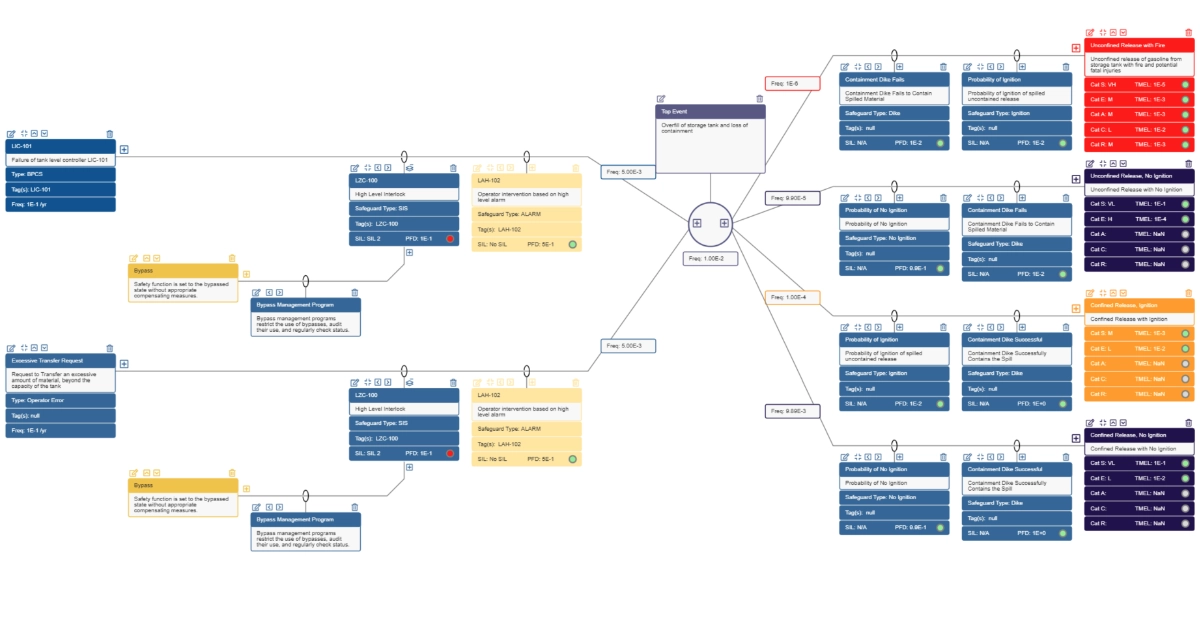
Exploring the Power of Bowtie Diagrams: Kenexis Launches Bowtie-Q™ Quantitative Bowtie Software
First and foremost, this webinar provides a firsthand look at the new features and capabilities of Bowtie-Q™. It will show you how the software simplifies the creation of Bowtie Diagrams and integrates seamlessly with other risk management frameworks. You will also gain insights into how Bowtie-Q™ helps with compliance, audits, and training, and discover how it can boost efficiency and decision-making across various industries, from manufacturing to oil and gas.
The webinar is not just a demo; it’s a chance to hear from an industry expert about how Bowtie-Q™ can be tailored to meet your specific needs. You’ll learn about best practices for risk assessment, control measures, and incident investigation—knowledge that could be pivotal in preventing costly mistakes and improving overall safety in your organization.
In short, the Kenexis Bowtie-Q™ launch webinar is a unique opportunity to stay ahead of the curve in risk management. Whether you are already familiar with Bowtie Diagrams or are just starting to explore their potential, Bowtie-Q™ promises to elevate your risk management strategies to the next level.

Manual Shutdown in Safety Instrumented Systems (SIS)
In accordance with IEC 61511, the manual activation of Safety Instrumented Systems (SIS) is typically required when automated safety actions are insufficient or unavailable, or when human intervention is necessary for system recovery. The standard outlines that manual activation should be an option for addressing specific safety functions that cannot be handled by automated systems in certain failure modes. This can be the case when there is an emergency condition or when the system fails in such a way that it requires operator action to restore the safe state or to prevent further escalation of hazards. The manual activation process must be well-defined, tested, and incorporated into the system’s overall safety management plan.
In this webinar, we cover key standards and guidelines, considerations for implementing manual shutdown, and various options for effective deployment. We also guide you through the Manual Shutdown Design Workflow, ensuring you have the insights needed to meet both industry requirements and operational safety needs.
The webinar starts with a focus on standards requirements for manual shutdown, including the critical provisions outlined in IEC 61511 and ISA 84. We explore the necessity of providing manual means to actuate SIS final elements, such as emergency stop buttons, when required by the Safety Requirements Specification (SRS). We also discuss when and why manual shutdown mechanisms may or may not be needed based on system reliability and operational considerations.
We then move on to considerations for implementation, exploring key questions such as whether alternative methods (like BPCS) could achieve the same outcomes, when manual activation may offer advantages, and how to address timing concerns. Various options for manual means will be discussed, including operator interfaces, direct wiring to SIS inputs, and methods for disconnecting power or individual final elements. The session concludes with a review of the manual shutdown design workflow, from aligning with standards requirements to creating datasheet entries and justifications for manual means. Don’t miss this chance to enhance your understanding of manual shutdown in SIS systems.
This webinar is part of Kenexis’ ongoing commitment to providing the industry with the tools and knowledge needed to ensure the highest standards of safety and compliance.

Safety Configured PLCs vs Safety PLCs
The logic solver is a critical part of a safety PLC, and you have a wide variety of options. It is possible to design a safety instrumented function that does not use a logic solver at all, simply wire the input switch to the output solenoid valve. But most applications benefit from a logic solver system that handles multiple inputs and outputs and can perform complex logic. While electrochemical and even pneumatic relay systems are still in use, most of the responsibility of performing SIS logic falls to programmable logic solvers, or in the language of the IEC 61511 standard, programmable electronic systems.
There are a wide variety of programmable logic controllers (PLC) available, some are suitable for safety applications, while others are not – at least not directly out of the box. The IEC standard provides requirements for the selection of components with which a safety instrumented system is built. These requirements are contained in Clause 11.5. In a simple summary, either a device is designed and manufactured in accordance with IEC 61508, or you have prior use experience with the device. Devices that are designed and manufactured in accordance with IEC 61508 are often referred to by the shorthand of “certified”, because when a vendor goes to this level of effort, they usually get an independent third-party certification body to vouch for their work.
Use of “non-certified” PLCs or commercial off the shelf (COTS) systems is allowed by the standard. First off, they are limited to SIL 2 (and realistically SIL 1, once you see what is required to achieve SIL 2), and they must be safety configured. Safety configuration is the process of engineering a COTS PLC with all of the required diagnostics to detect all known failure modes and take the process to a safe state if a failure is detected. This is a complex process of including watch dog timers, wiring outputs back to inputs, input redundancy with voting, and external master trip relays.
The topic of safety configuration is discussed in this webinar, including the degree of complexity and all the actions that are required to be undertaken. This will also include a detailed discussion of clause 11.5 in the standard where the safety configuration requirements are contained.
This webinar is part of Kenexis’ ongoing commitment to providing the industry with the tools and knowledge needed to ensure the highest standards of safety and compliance.
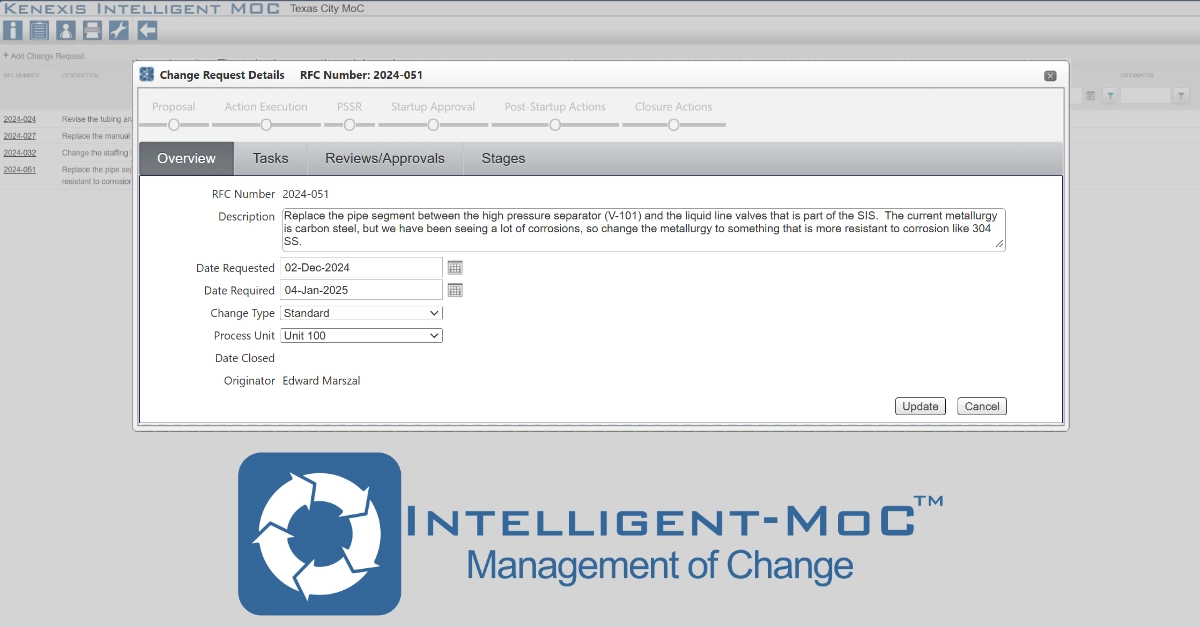
Kenexis Intelligent MoC™ Beta Program
We’re looking for beta testers! View this recorded webinar to learn more about setting up an MoC workflow…
Establishing a robust Management of Change (MoC) program is essential for ensuring the safety, reliability, and regulatory compliance of chemical processes. One of the first and most critical steps in setting up an effective MoC program is defining the workflow and approval process. This step lays the foundation for a structured approach to managing changes while minimizing risks. Kenexis’ new Intelligent MoC™ software, which is entering its Beta Testing Program, makes this process seamless by providing tools to automate, document, and enforce workflows tailored to your organization’s needs.
The workflow for an MoC program determines the stages a change must pass through, the disciplines involved, and the responsibilities of each stakeholder. Typical stages might include initiation, risk assessment, design review, approval for implementation, execution, and final verification. Defining these stages ensures that no critical steps are overlooked and that all relevant aspects of the change—from technical feasibility to regulatory compliance—are addressed. Intelligent MoC™ enables organizations to standardize these workflows, ensuring consistency and clarity across all change management activities.
Equally important is defining the approval process. Changes in chemical processes often require input and sign-off from multiple disciplines, including operations, engineering, maintenance, safety, and environmental teams. Intelligent MoC™ allows users to configure approval requirements based on specific roles and responsibilities, ensuring that the right people are reviewing and authorizing changes at the right time. Automated notifications and tracking features ensure that no approvals are missed, enhancing accountability and efficiency.
By leveraging Intelligent MoC™ to define workflows and approval processes, organizations can reduce the complexity and administrative burden of managing change. The software’s automation capabilities streamline the entire process, from initiation to closure, while maintaining a comprehensive audit trail for compliance and performance improvement. With Intelligent MoC™, you can confidently manage changes in your chemical processes, knowing that every step is documented and aligned with industry best practices. Start building a safer and more efficient future by implementing Intelligent MoC in your MoC program today.
This webinar is part of Kenexis’ ongoing commitment to providing the industry with the tools and knowledge needed to ensure the highest standards of safety and compliance.

Understanding Human and Systematic Failures in Safety Instrumented Systems
In industrial safety, Safety Instrumented Systems (SIS) are crucial for protecting processes from hazards. However, one area that often causes confusion is how human and systematic failures are addressed in comparison to random hardware failures. The IEC 61511 standard provides valuable guidance on this distinction, helping organizations ensure compliance and maintain safety integrity.
Human vs. Hardware Failures
The IEC 61511 Approach While random hardware failures can be quantified using the Probability of Failure on Demand (PFD) metric, human and systematic failures are not captured by these calculations. Attempting to apply PFD calculations to human failures often leads to misguided solutions—such as increasing redundancy or testing—that may exacerbate the issue. This is where IEC 61511 takes a different approach. Human and systematic errors typically arise from flaws in processes, designs, or execution. Unlike hardware failures, which can be addressed through reliability data and redundancy, these errors require a more qualitative approach. IEC 61511 emphasizes that administrative controls—rather than hardware-based solutions—are key to managing these risks.
Administrative Controls and Functional Safety Planning
IEC 61511’s framework for addressing human and systematic failures focuses on functional safety planning throughout the lifecycle of the SIS, from design to decommissioning. Key activities such as verification, validation, functional safety assessments, and regular audits are essential components of this strategy. These measures are designed to ensure that potential human and systematic errors are identified and mitigated proactively.
Recorded Webinar
To explore these concepts in more detail, this webinar provides an in-depth discussion of how IEC 61511 addresses human and systematic failures, explaining why they are excluded from PFD calculations and how administrative controls play a vital role in reducing their impact. Best practices for implementing these controls will also be shared, helping you align your SIS with compliance requirements while meeting real-world safety demands. Whether you’re a process engineer, safety manager, or functional safety professional, this webinar will equip you with the knowledge and tools to navigate the complexities of human and systematic failures. Don’t miss out on this opportunity to enhance your safety management practices and ensure the effectiveness of your Safety Instrumented Systems.
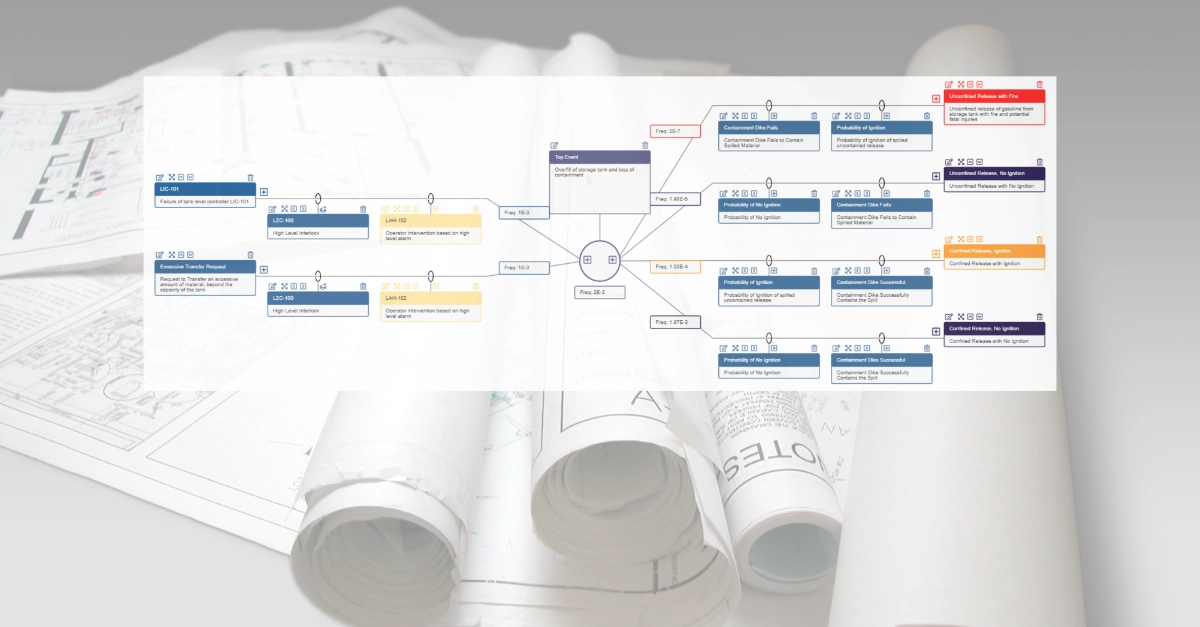
Quantitative Bowtie Analysis
Bowtie diagrams are a valuable tool for understanding and visualizing risk management, but their traditional qualitative approach has its limits. While they effectively show how threats, barriers, and consequences are interrelated, they often fall short when it comes to providing the details needed for more informed decision-making. That’s where quantitative bowtie analysis comes in.
In this webinar, we explore how quantitative analysis enhances bowtie methodology by incorporating numerical values for the probabilities and frequencies of threats and consequences. This deeper layer of insight helps us move beyond general visualizations to a more precise, data-driven understanding of risk.
You’ll learn how to:
- Calculate the frequency of threats and assess their potential impact.
- Evaluate the likelihood of the top event occurring, helping prioritize risk management efforts.
- Quantify the frequency of consequences to better understand the full range of potential outcomes.
With quantitative bowtie analysis, you can approach risk management with greater confidence, applying a structured and analytical process to reduce uncertainty and improve decision-making.
Don’t miss this opportunity to learn how to take your risk management practices to the next level.
This webinar is part of Kenexis’ ongoing commitment to providing the industry with the tools and knowledge needed to ensure the highest standards of safety and compliance.

Development of General Failure Data for SIS Components
This insightful webinar on the calculation of the average Probability of Failure on Demand (PFD) for Safety Instrumented Functions (SIFs), a crucial step in the IEC 61511 safety lifecycle. This session will delve into how PFD depends on various factors, including component failure rates sourced from:
- Vendor data from Failure Modes Effects and Diagnostics Analysis
- Vendor data from field returns
- Field data from operating plants
- Industry data from groups of companies
- Generic data compiled from industry sources
Edward Marszal, President of Kenexis, highlights how Kenexis and other organizations analyze both publicly available and proprietary data to provide “generic” failure rates. Learn about the expert judgment involved in drawing from key sources like the ISA Technical Report, CCPS, OREDA, and NPRD.
The webinar also covers how Kenexis combines data from diverse sources and applies expert analysis to adjust failure rates based on industry relevance and specific failure modes. Discover how these rates are conservatively selected to meet IEC 61511 standards, ensuring a 70% confidence level that actual failure rates are likely lower than estimated.
This webinar is part of Kenexis’ ongoing commitment to providing the industry with the tools and knowledge needed to ensure the highest standards of safety and compliance.

Executing a Functional Safety Assessment in Compliance with IEC 61511 using Open Audit™
In this webinar, we explore the critical topic of conducting a Functional Safety Assessment (FSA) in accordance with IEC 61511 using Kenexis’ innovative Open Audit™ software. This session is designed for safety professionals, engineers, and decision-makers who are looking to enhance their understanding of FSAs and improve the efficiency and accuracy of their safety processes.
What You’ll Learn:
- Introduction to Functional Safety Assessments (FSA):
- Understanding the role of FSAs in the lifecycle of a Safety Instrumented System (SIS).
- Key requirements and steps as outlined in IEC 61511.
- Common challenges and pitfalls in conducting FSAs.
- Overview of IEC 61511 Compliance:
- A deep dive into the IEC 61511 standard and its relevance in ensuring the safety of process industry operations.
- Best practices for maintaining compliance throughout the safety lifecycle.
- Demonstration of Open Audit Software:
- An in-depth look at how Open Audit™ software by Kenexis simplifies the FSA process.
- Features and tools that enhance audit efficiency, transparency, and accuracy.
- Real-world examples of how Open Audit™ can be applied to assess safety functions.
Why Attend?
Conducting a Functional Safety Assessment is a vital part of ensuring that Safety Instrumented Systems (SIS) perform as required to mitigate risks effectively. Compliance with IEC 61511 is not just a regulatory requirement but a best practice for safeguarding lives, assets, and the environment.
By attending this webinar, you will gain valuable knowledge on how to execute FSAs efficiently using our Open Audit™ software, which is designed to streamline the assessment process and ensure that all safety-critical functions are thoroughly evaluated.
Whether you are new to FSAs or looking to refine your process, this webinar will provide you with the tools and knowledge to elevate your safety practices.
Who Should Attend?
- Functional Safety Engineers
- Process Safety Managers
- HSE Professionals
- Compliance Officers
- Anyone involved in the safety lifecycle of process operations
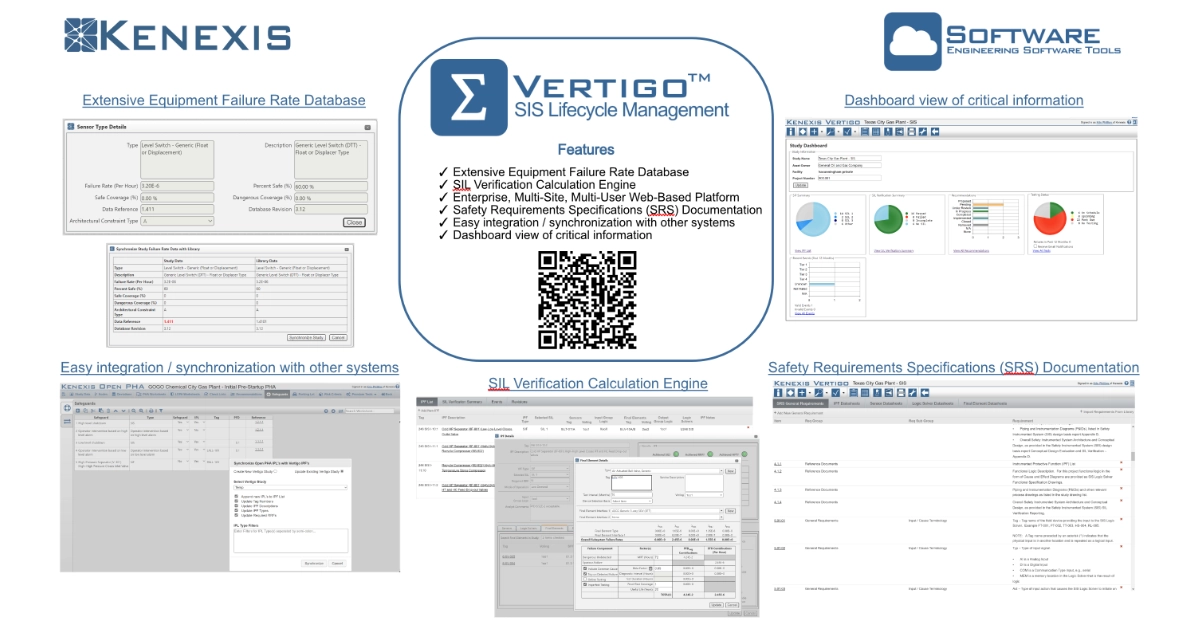
Maximize Safety and Efficiency with Vertigo™ – Your Ultimate SIS Lifecycle Management Software Solution!
Ensure your Safety Instrumented Systems (SIS) are developed, documented, tracked, and maintained with the highest level of precision throughout their entire lifecycle using Vertigo™. Whether you’re handling a single site or an entire enterprise, Vertigo™ has you covered.
With Vertigo™, seamlessly integrate your Instrumented Protective Functions (IPFs) directly from Open-PHA® Cloud or enter them manually. Leverage Kenexis’ extensive failure rate data or use your own to perform accurate SIL Verification Calculations. Vertigo™ empowers you to develop and track Safety Requirement Specifications (SRS) through customizable datasheets or clause-based general requirements.
In this webinar, Kenexis President Ed Marszal presents a comprehensive demonstration of all the features and benefits of Vertigo™.
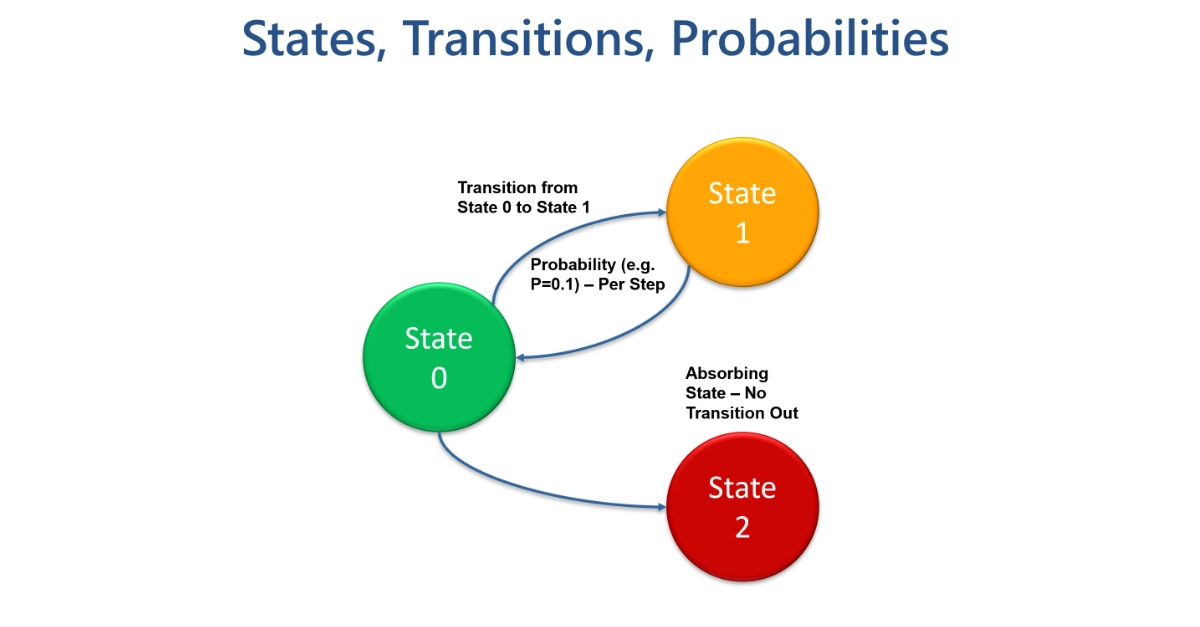
Markov Modeling Overview
Markov modeling is a powerful tool in reliability engineering, known for its ability to model complex systems with unconventional repair schemes and multiple stages of degradation. Although Markov models may appear complex and intimidating, they are ultimately systematic and straightforward. While they are invaluable in certain specialized situations, they often unnecessarily complicate the analysis process and only approximate the accuracy of standard equations. For example, in a simple one-out-of-two voting arrangement, a Markov model merely approaches the accuracy of analytical solution equations but demands significantly more computational effort.
In this webinar, Kenexis President Ed Marszal presents a comprehensive tutorial on Markov models. The webinar aims to demystify Markov models, highlight the scenarios where they are most useful and effective, discuss their limitations and potential inaccuracies, and introduces the methods for their construction and solution.
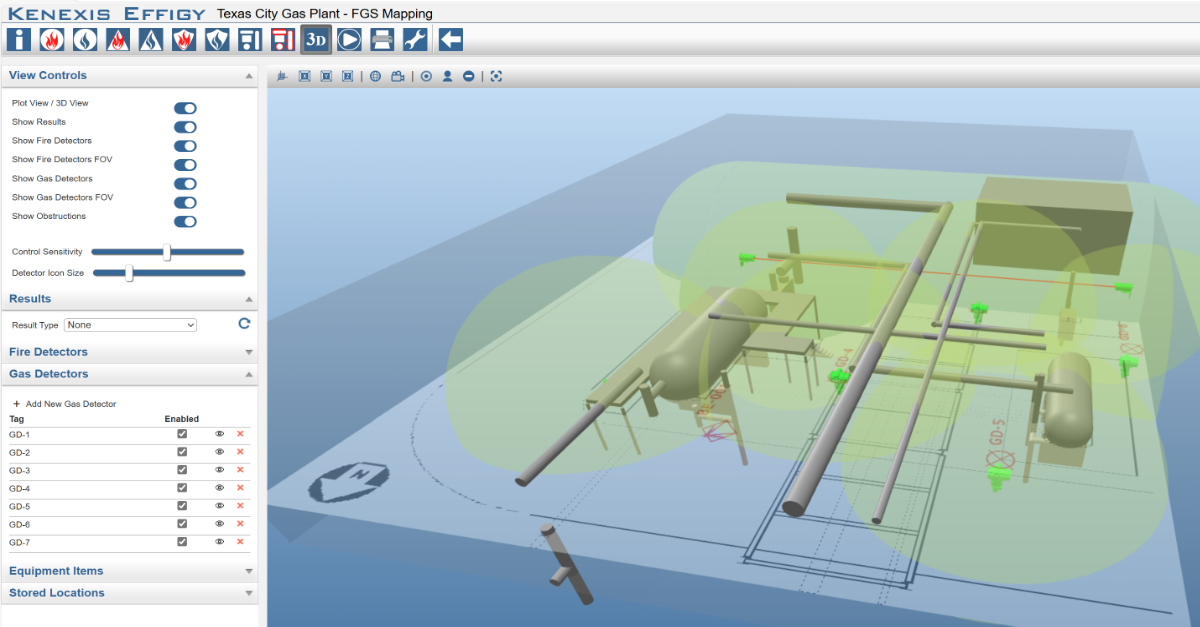
SIF Definitions during the SIS Safety Lifecycle
Defining safety instrumented functions is a critical task that happens very early in the SIS safety lifecycle. Mistakes during this phase can cascade into errors persisting throughout the entire SIS safety lifecycle. Some common errors include associating every action for a sensor in a cause-and-effect diagram, ignoring multiple sensors that can detect a hazardous condition, and improperly voting a large number of sensors – many of which cannot detect a hazard simultaneously.
This webinar presents a series of rules that will allow SIS designers to properly define safety functions prior to SIL selection and SIL verification steps.
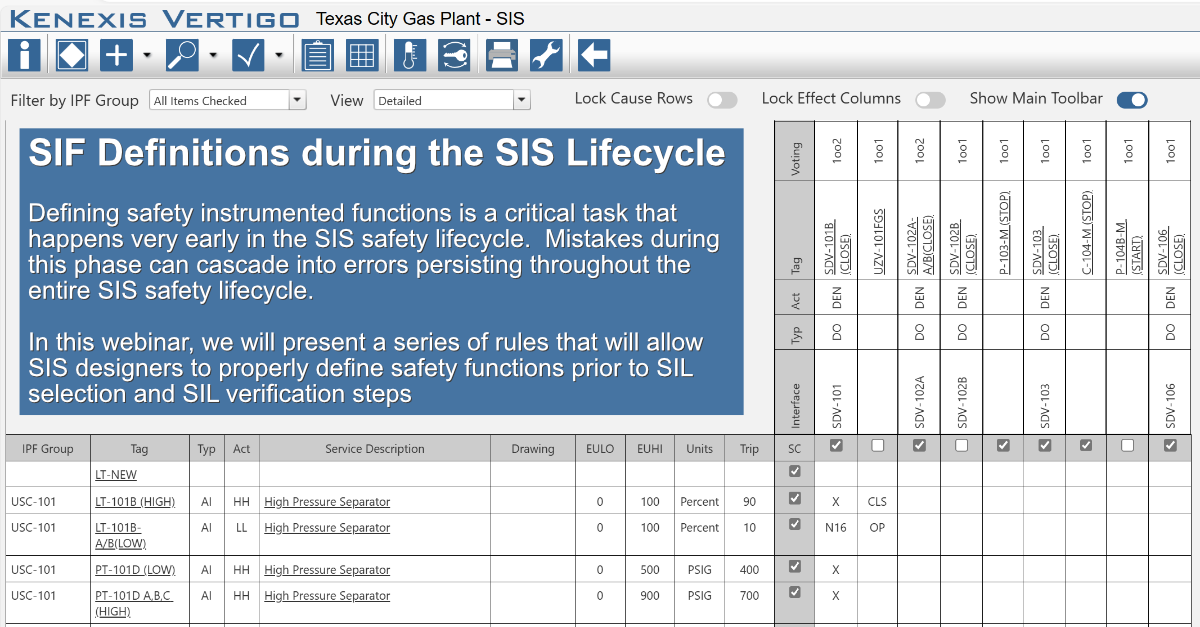
SIF Definitions during the SIS Safety Lifecycle
Defining safety instrumented functions is a critical task that happens very early in the SIS safety lifecycle. Mistakes during this phase can cascade into errors persisting throughout the entire SIS safety lifecycle. Some common errors include associating every action for a sensor in a cause-and-effect diagram, ignoring multiple sensors that can detect a hazardous condition, and improperly voting a large number of sensors – many of which cannot detect a hazard simultaneously.
This webinar presents a series of rules that will allow SIS designers to properly define safety functions prior to SIL selection and SIL verification steps.
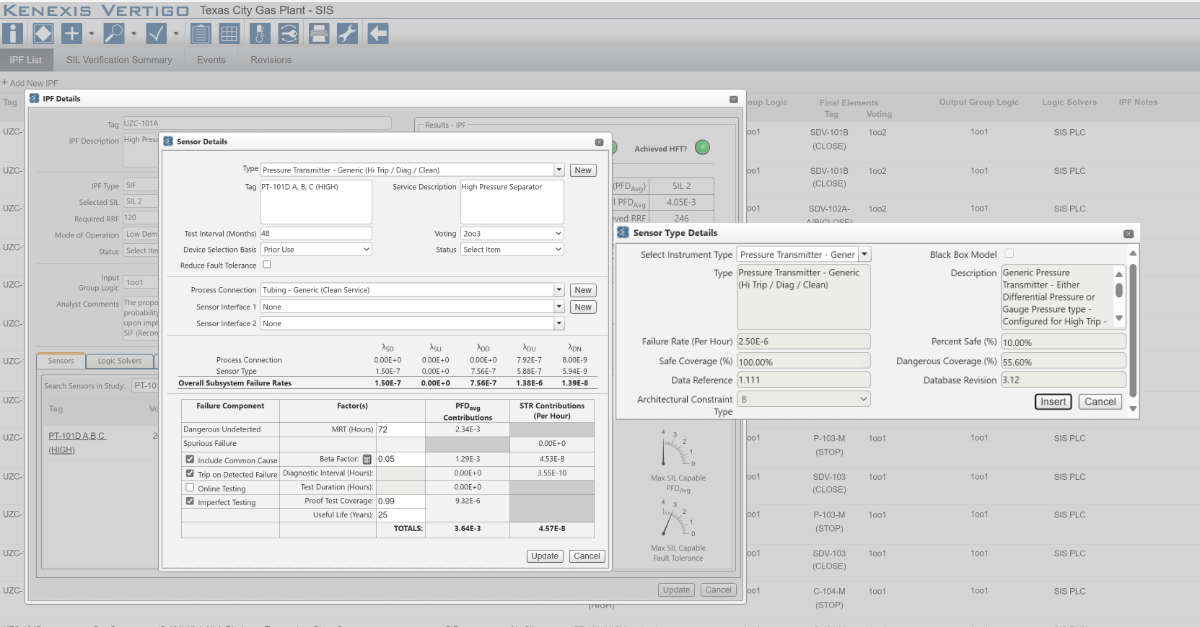
Failure Rate Units, Format and Conversion
Failure data appears in various shapes, forms, and formats. Different units are often utilized, such as failures per hour, failures per million hours, and FITS. Further, data may be expressed as an overall failure rate, safe failure percentage fractions, and coverage factors. At times, it is separated into categories like dangerous detected, dangerous undetected, and dangerous never detected. Proficiency in comprehending and converting between these presentation types and units is a critical SIS engineering skill.
In this webinar, we cover all commonly used representations of failure rates, explore the various units in which these rates can be expressed, and provide guidance on converting between different formats.
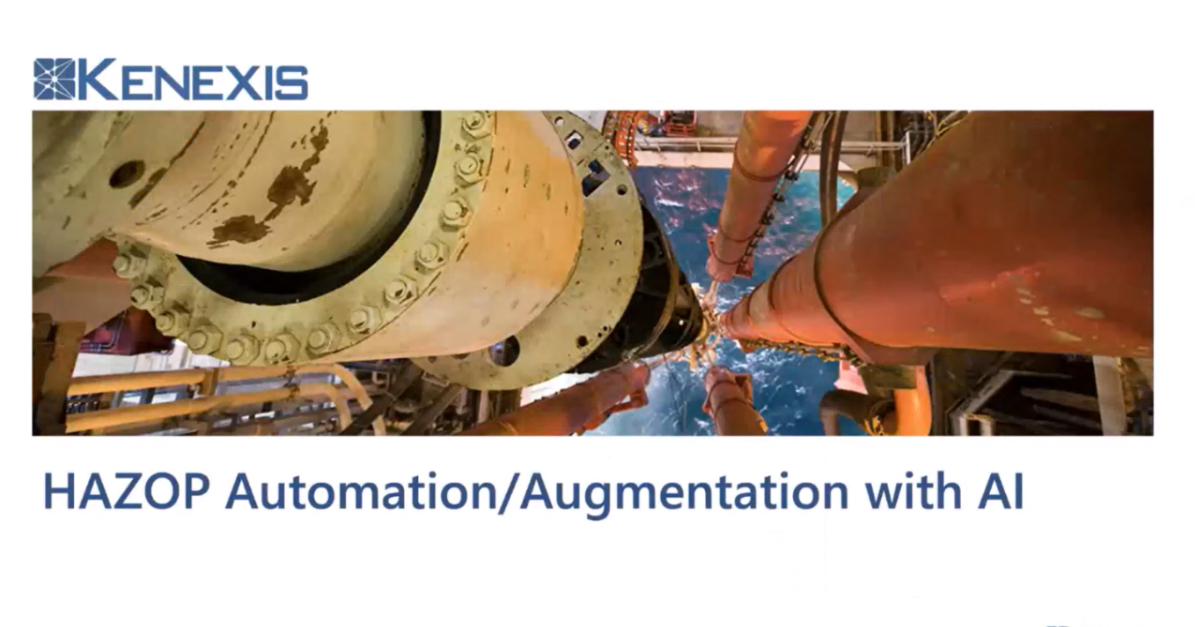
Using Large Language Models AI for HAZOP Automation and Augmentation Tool
Hazards and operability studies (HAZOP) are a critical first step in ensuring safe chemical process facilities. Unfortunately, they are time and resource intensive. Even good HAZOP studies can miss many very significant scenarios or come to insufficient conclusions.
This problem is being exacerbated by the loss of corporate memory that results from experienced personnel leaving the workforce. Research is currently being performed to employ artificial intelligence tools like Generative Pretrained Transformers (e.g., Chat GPT) to assist, or potentially complete automate the HAZOP process. To be effective, the GPT will have to be applied to curated datasets that only contain trusted engineering knowledge that is strictly proprietary – removing the “junk” general knowledge that hampers their performance.
Join President of Kenexis, Edward Marszal, who elaborates on this subject during this webinar. The webinar begins with a discussion of the fundamentals of AI from its inception, starting with expert systems that were abandoned for fuzzy logic and neural networks that underpin modern large language models such as GPT. We then discusses how HAZOP data such as HAZOP and LOPA worksheets can be fed into a large language model and how a GPT will create a model for predicting information in a HAZOP based on training data.
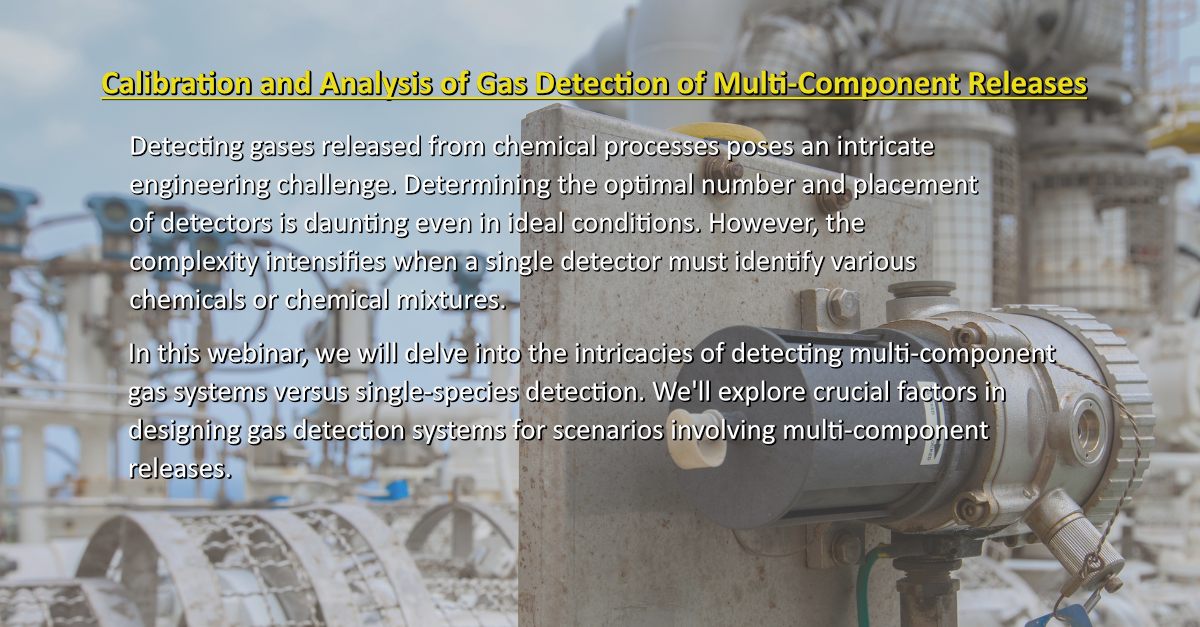
Calibration and Analysis of Gas Detection of Multi-Component Releases
Detecting gases released from chemical processes poses an intricate engineering challenge. Determining the optimal number and placement of detectors is daunting even in ideal conditions. However, the complexity intensifies when a single detector must identify various chemicals or chemical mixtures. Gas detectors are typically calibrated to recognize specific chemicals, meaning exposure to different substances yields disparate measurements.
In this webinar, we delve into the intricacies of detecting multicomponent gas systems versus single-species detection. We’ll explore crucial factors in designing gas detection systems for scenarios involving multicomponent releases.
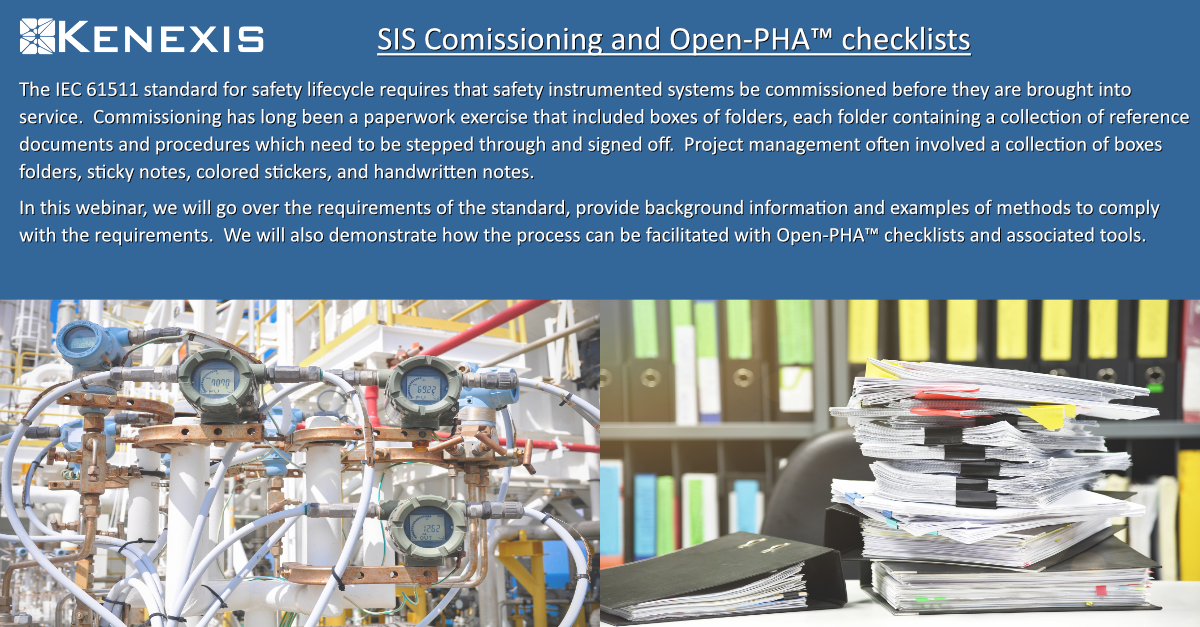
SIS Commissioning – Open-PHA™ Checklist
Join Kenexis President Ed Marszal in this webinar where he discusses IEC 61511 commissioning requirements, offering insights, examples, and showcasing the use of Open-PHA™ checklists and associated tools.
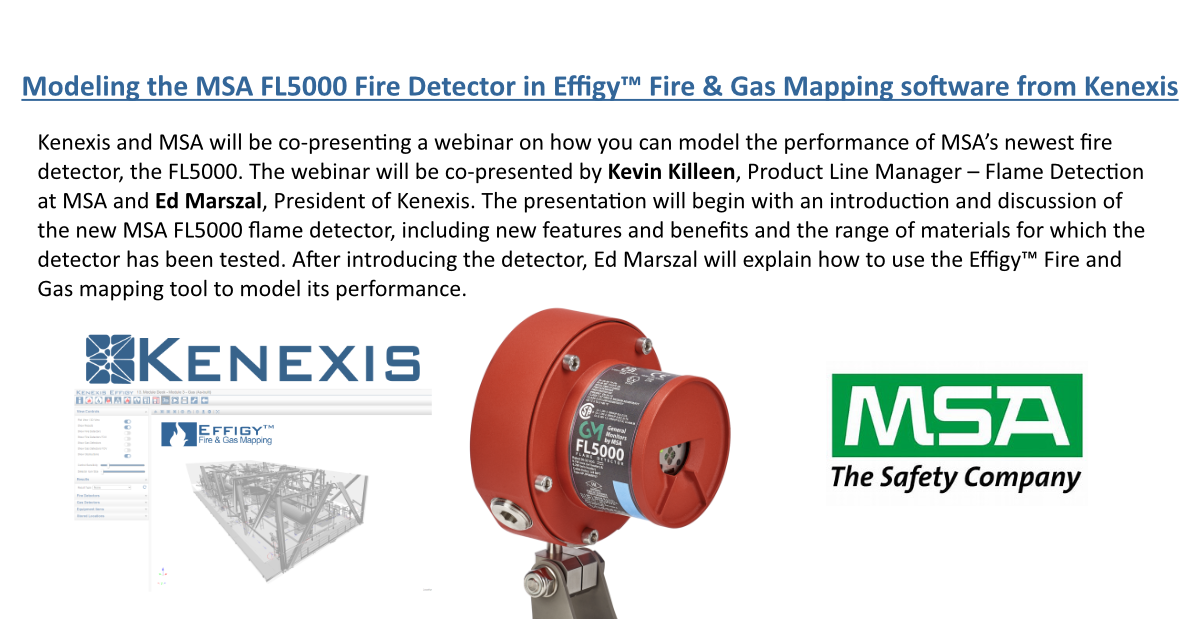
MSA & Kenexis co-webinar – the new MSA FL5000 Fire Detector and modeling in Effigy™ Fire & Gas Mapping software
This recorded, co-presented webinar begins with Kevin Killeen, Product Line Manager-Flame Detection of MSA, introducing and discussing the new FL5000 fire detector’s features and benefits. From there Edward Marszal, President of Kenexis, explains how to model this new detector’s performance in Effigy™ Fire and Gas Mapping software from Kenexis.
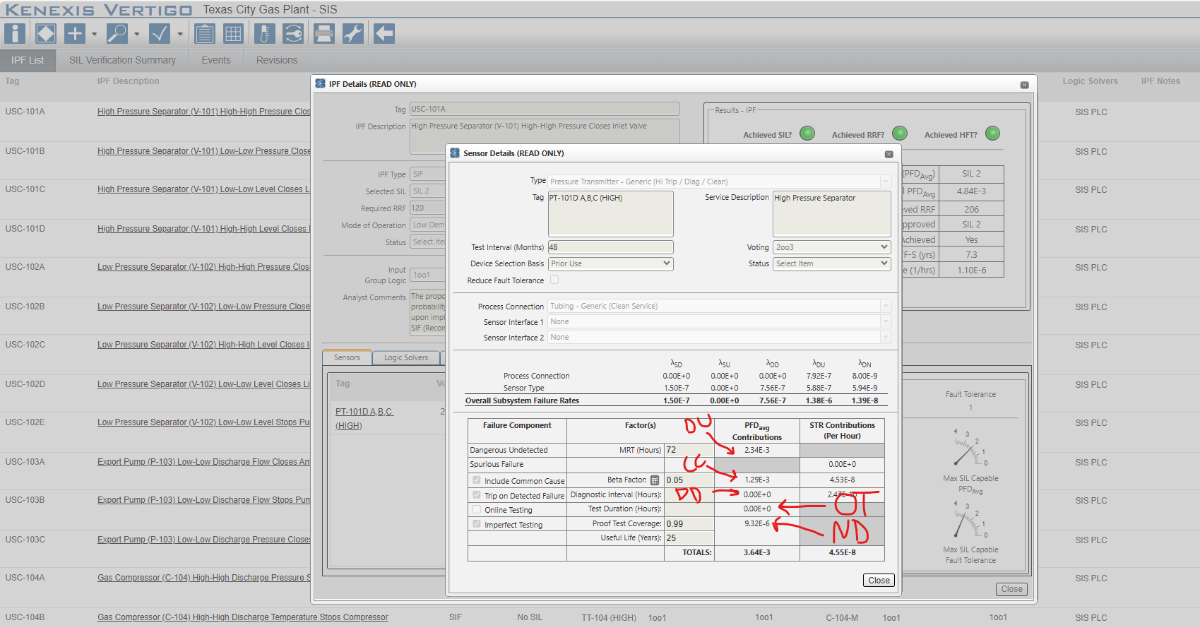
SIL Verification Calculation Terms
This webinar presents all the terms used in SIL verification calculations. The means to calculate and the physical meaning of all the terms are discussed along with their equations – as shown in the IEC EC50 training class on functional safety. The webinar also shows how these terms are treated and displayed in the best-in-class Kenexis Vertigo software for SIS safety lifecycle management.
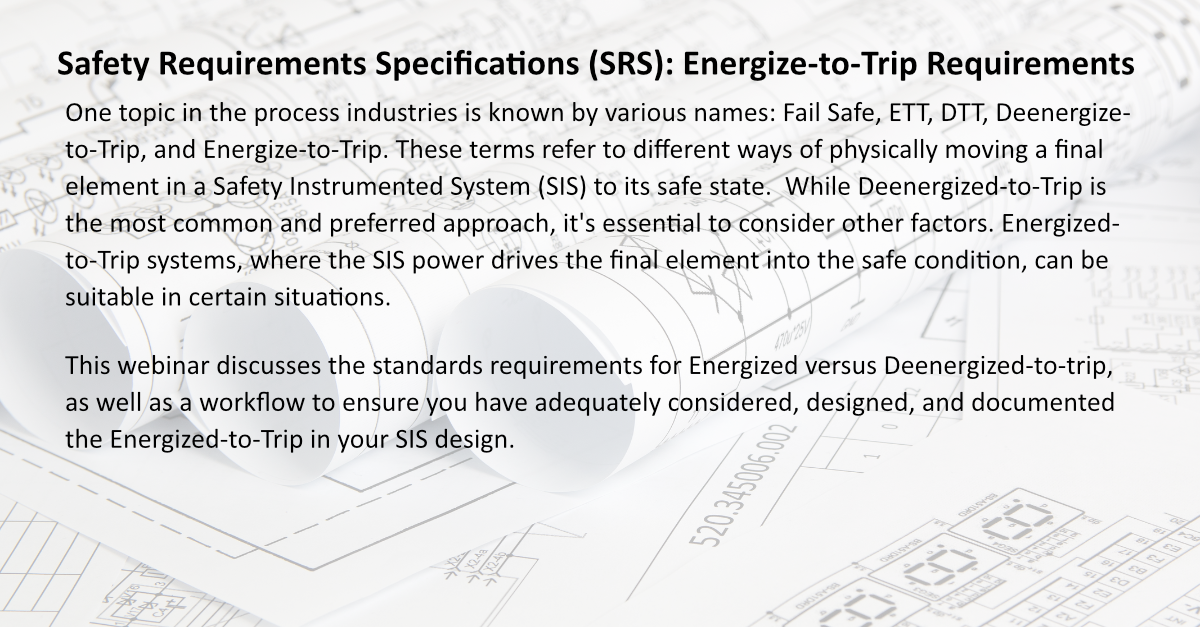
Safety Requirements Specifications (SRS): Energize-to-Trip Requirements September 2023
One topic in the process industries is known by various names: Fail Safe, ETT, DTT, Deenergize-to-Trip, and Energize-to-Trip. These terms refer to different ways of physically moving a final element in a Safety Instrumented System (SIS) to its safe state. While Deenergized-to-Trip is the most common and preferred approach, it’s essential to consider other factors. Energized-to-Trip systems, where the SIS power drives the final element into the safe condition, can be suitable in certain situations. This webinar discussed the standards requirements for Energized versus Deenergized-to-trip, as well as a workflow to ensure you have adequately considered, designed, and documented the Energized-to-Trip in your SIS design.
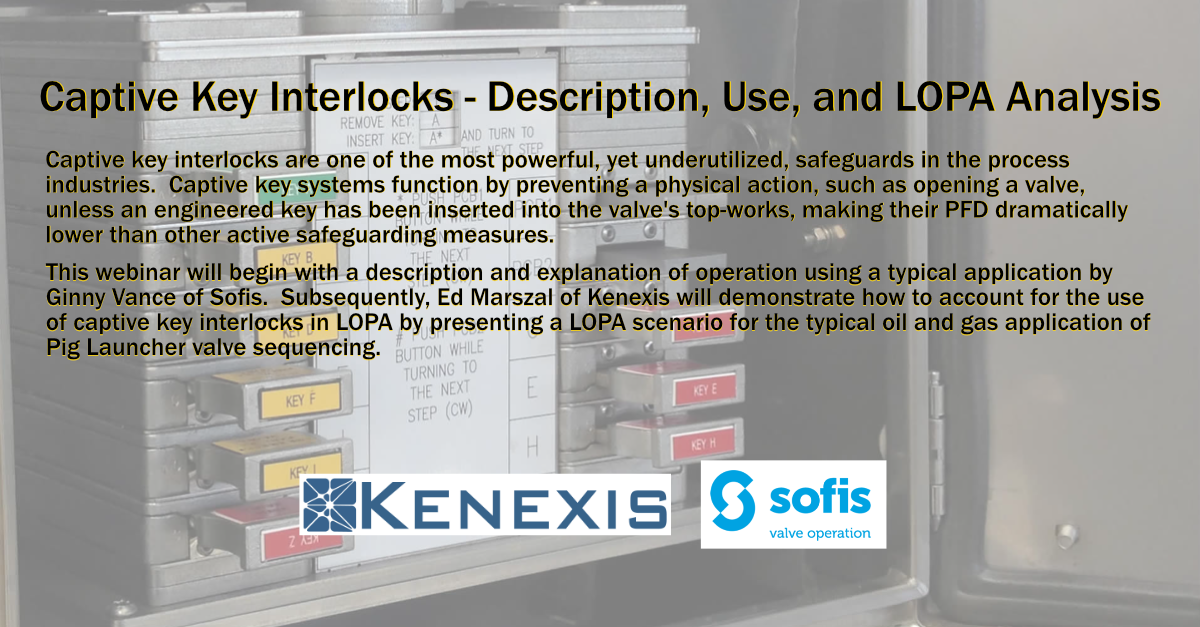
Captive Key Interlocks – Description, Use, and LOPA Analysis
Captive key interlocks are one of the most powerful, yet underutilized, safeguards in the process industries. Captive key systems function by preventing a physical action, such as opening a valve, unless an engineered key has been inserted into the valve’s topworks. Once the valve is moved, the key cannot be removed until the valve has been completely cycled. This physical interlocking enforces a specific sequence of operations and prevents valve misalignment, improper opening, and other potentially catastrophic operational errors. These interlocks are simple and effective. Essentially, they can only fail if they are installed incorrectly or physically tampered with, making their PFD dramatically lower than other active safeguarding measures.
This webinar will begin with a description and explanation of operation using a typical application by Ginny Vance of Sofis. Subsequently, Ed Marszal of Kenexis will demonstrate how to account for the use of captive key interlocks in LOPA by presenting a LOPA scenario for the typical oil and gas application of Pig Launcher valve sequencing.

Hydrogen Gas Detection For Electrolyzers
Engineers in the chemical process industries face the task of shifting society away from energy sources that emit carbon dioxide or other greenhouse gases. While numerous methods of storing green energy are being considered, there is significant interest in converting green electricity into chemical energy that is easier to store and transport. The most common approach involves producing hydrogen from water through electrolysis and utilizing the hydrogen directly or converting it into ammonia or other chemicals for improved transportability and energy density.
Hydrogen is emerging as a prominent candidate for driving the transition to green energy. However, like any potential energy source, hydrogen can pose risks if mishandled, as hydrogen is highly flammable, oxygen acts as an oxidizer. Consequently, the release of hydrogen can create hazardous conditions with significant safety implications. To mitigate these risks, a widely used safety measure is the implementation of a gas detection system with automatic shutdown capabilities.
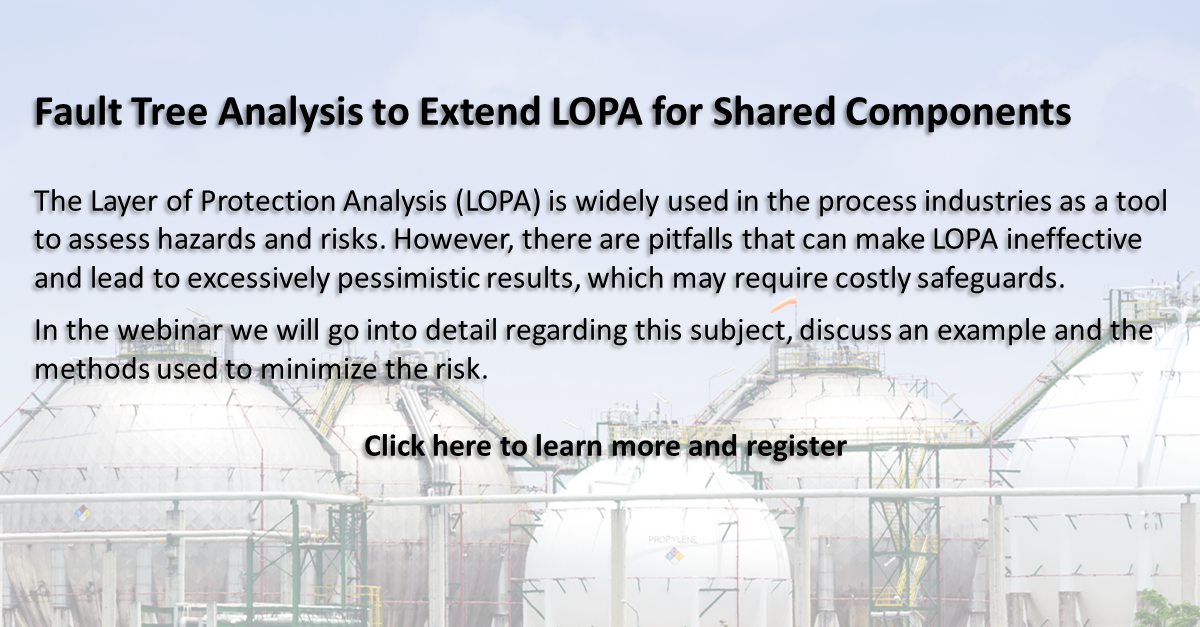
Fault Tree Analysis to Extend LOPA for Shared Components
The Layer of Protection Analysis (LOPA) is widely used in the process industries as a tool to assess hazards and risks. Typically, organizations in the chemical process industry employ a process hazards analysis (PHA) program, which begins with a facilitated workshop study, often using techniques like hazards and operability studies (HAZOP). This study triggers further analysis in certain situations, such as scenarios involving high consequences, complexity, quantitative performance targets for safeguards, very high-cost recommendations, or insufficient risk assessment. In such cases, additional analysis, often more comprehensive than the PHA, is necessary. LOPA is frequently chosen as the technique of choice, as it is more comprehensive than PHA but less resource-intensive than fully quantified risk analysis.
However, there are pitfalls that can make LOPA ineffective and lead to excessively pessimistic results, which may require costly safeguards. If LOPA presents inappropriate results, alternative quantitative tools should be considered to address its limitations. These tools need not be used to their fullest extent, but rather selectively applied to specific applications where LOPA is inadequate. Some of these quantitative tools include dispersion models, explosion models, consequence effects models, event tree analysis, quantitative bowtie analysis, and fault tree analysis.
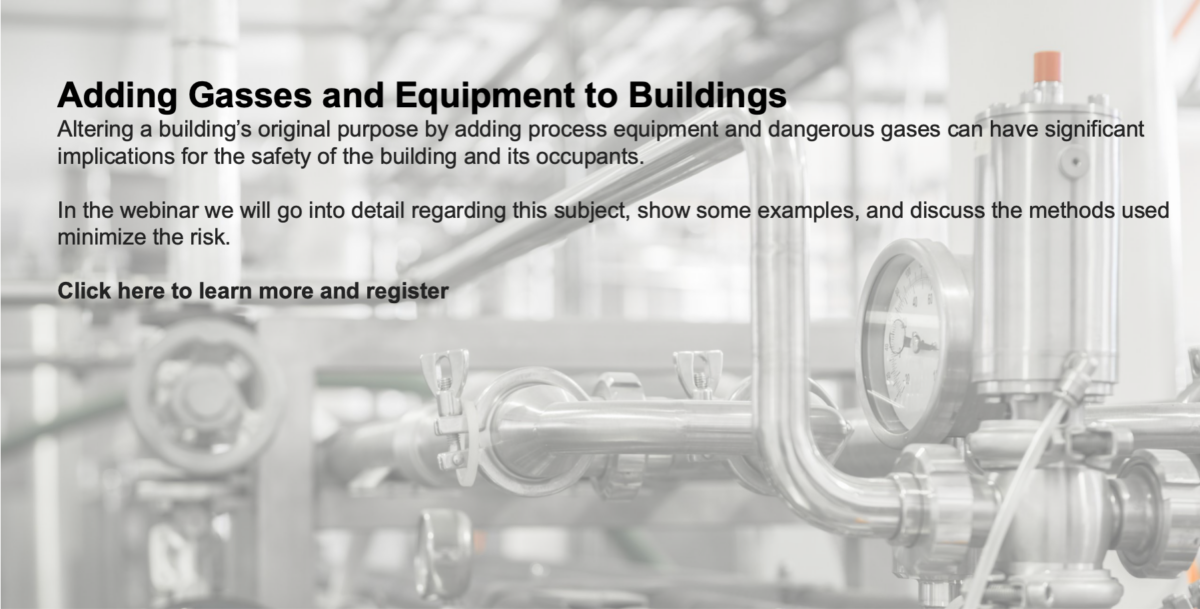
Adding Gasses and Equipment to Buildings
Altering a building’s original purpose by adding process equipment and dangerous gases can have significant implications for the safety of the building and its occupants. Whether it is apparently minor or major, significant modifications to the building’s structure, electrical and plumbing systems, and ventilation, among other things may be required for safety purposes.
The addition of process equipment and dangerous gases introduces new hazards into the building, including the risk of fire, explosion, and toxic gas leaks. This requires careful planning and implementation to ensure that the building’s safety systems can effectively manage these hazards.
Moreover, regulatory compliance may be necessary to ensure that the building meets all applicable safety standards, such as building codes, environmental regulations, and occupational safety requirements. Failure to comply with these regulations can result in fines, legal liability, and potentially serious safety consequences.
In summary, altering a building’s original purpose by adding process equipment and dangerous gases requires careful planning, implementation, and regulatory compliance to ensure the safety of the building and its occupants.
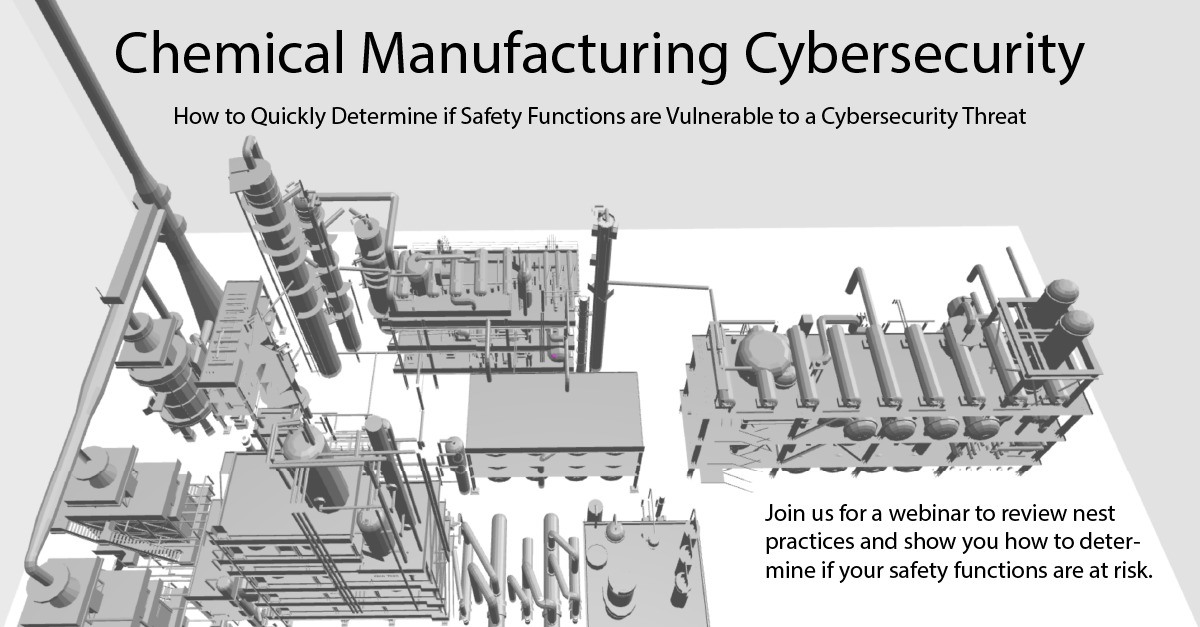
How to Quickly Determine if Safety Functions are Vulnerable to a Cybersecurity Threat
In this webinar, we will briefly cover the good cybersecurity principles like backing up everything, restricting access, and the other top ten things everyone should already be doing at a minimum. Then we will dive into how to perform a Security PHA Review (SPR) of your HAZOPs. An SPR is designed to help you quickly determine if any of your safety functions are vulnerable to a cybersecurity threat.
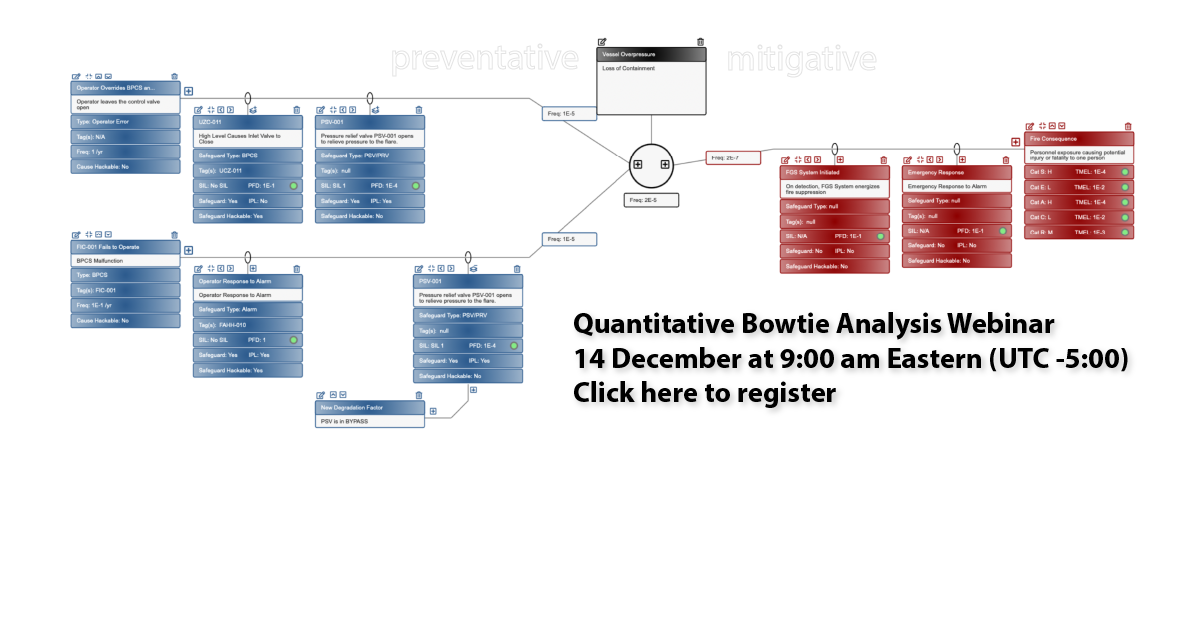
Quantitative Bowtie
Research into Unified Hazard Assessment combining HAZOP, LOPA, and Quantitative Bowtie Analysis has yielded techniques that elegantly address the limitations of LOPA and provided a significantly improved graphical communications method. This recorded webinar provides background on how Unified Hazard Assessment yielded the techniques of Quantitative Bowtie analysis. The webinar will also describe in detail how to implement quantitative bowtie analysis along with the mathematical concepts used for quantification of risk for multiple causes and multiple consequences inside a single scenario. The concepts will be presented using example studies that include mitigative safeguards and multiple cause scenarios.
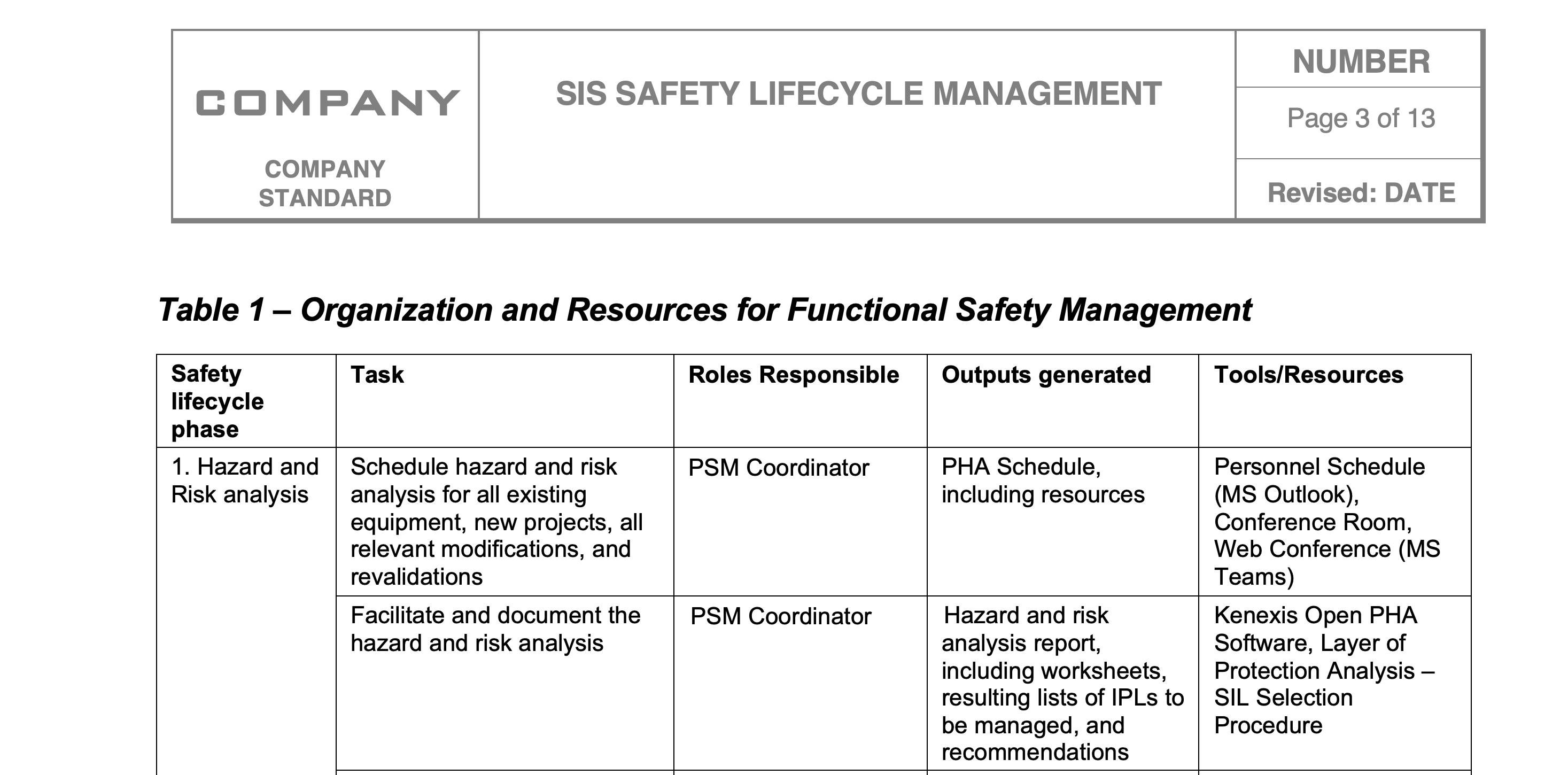
Can I see your Functional Safety Management Program documentation?
Planning Functional Safety (with Template Procedure)
A part of the IEC 61511 standard that does not get the attention that it deserves is clause 5 – Management of Functional Safety.
While most engineers want to focus on detailed design, risk analysis and SIL verification calculations, it is the management aspect that addresses the human failure portion of the risk equation.
In clause 5 we define the need for a plan to be made for functional safety. This plan needs to include the definition of tasks that occur during the SIS safety lifecycle along with assignments of who is responsible for these tasks. This clause also addresses items like competency and the assignment of SIS tasks to external organizations.
In this webinar we will highlight some of the information that is contained in the Kenexis course – SIS Management responsibilities. We will then move on to an explanation of the Kenexis Template SIS Safety Lifecycle Procedure along with recommendations on how to customize it for your organization. If you do not already have a safety lifecycle management procedure, this webinar and the template are a great starting point that will honestly get you most of the way to where you need to be.
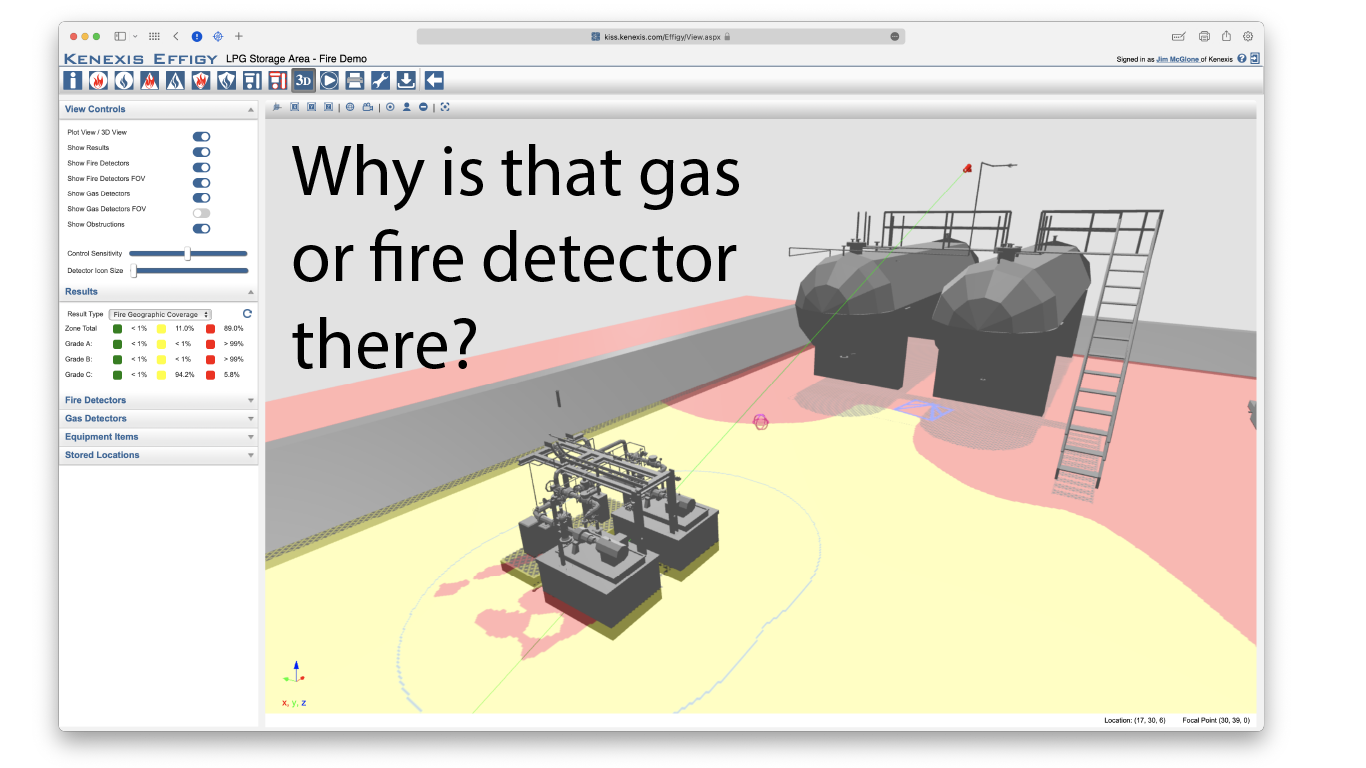
Why is that Detector There
Have you ever wondered why a gas or fire detector is installed at a location. Maybe someone walking through your facility asked you why a detector was installed at a particular location. Scrambling to find an answer at that point is probably useless, you already revealed that you don’t know and maybe no one else onsite knows.
In this webinar we will quickly go through how we engineer where detectors are positioned and some of the science behind the engineering. We will discuss the process and even design a small system live and calculate coverage to see if it meets the requirements.

SIS and BPCS Component Sharing
There is still some confusion about a key attribute of good Safety Instrumented Systems (SIS) design – specifically separation of Basic Process Control Systems (BPCS) and Safety Instrumented Systems (SIS). In this live webinar, we will cover Definitions and Standards Requirements, Assessment of Independence – Shared Valve System, Quantitative Justification of Shared Component, Additional Standards Requirements, Design of SIS Separation Workflow

Risk Assessment and Safeguarding of Lithium Ion Battery Containing Facilities
Join us for a recorded webinar discussing the challenges associated with Risk Assessment and Safeguarding of Lithium Ion Battery Containing Facilities
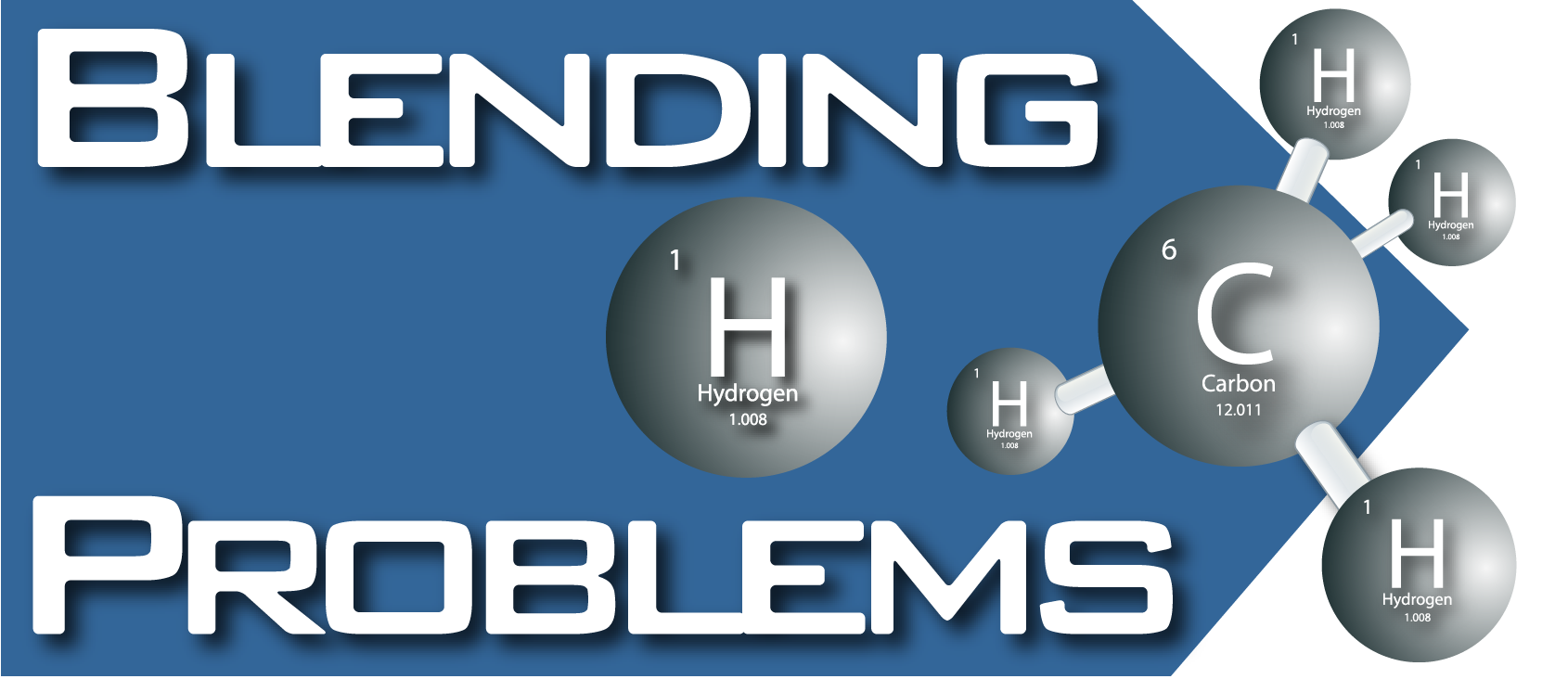
Problems Blending H2 into Natural Gas (Methane)
Join us for a recorded webinar on discussing some of the Problems Blending H2 into Natural Gas (Methane) including references to the papers and information presented in the video.
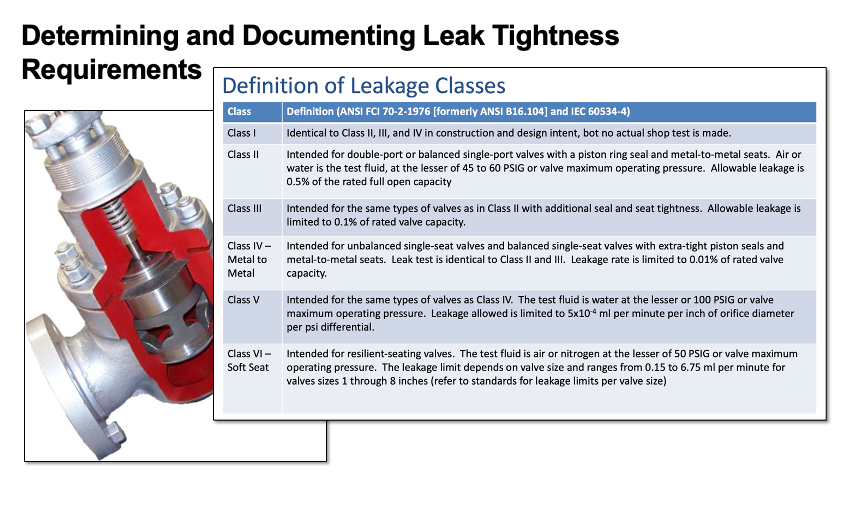
Determining and Documenting Appropriate Leak Tightness Requirements
This webinar goes into detail about the differences between tight shut off and leakage rate methods, the standards, and how to determine the correct leak requirements for your situation.
